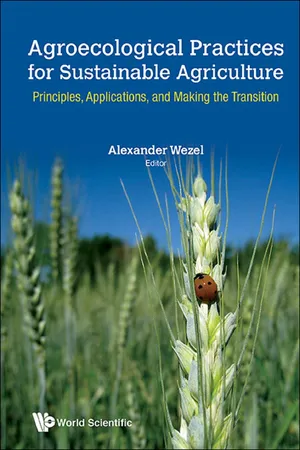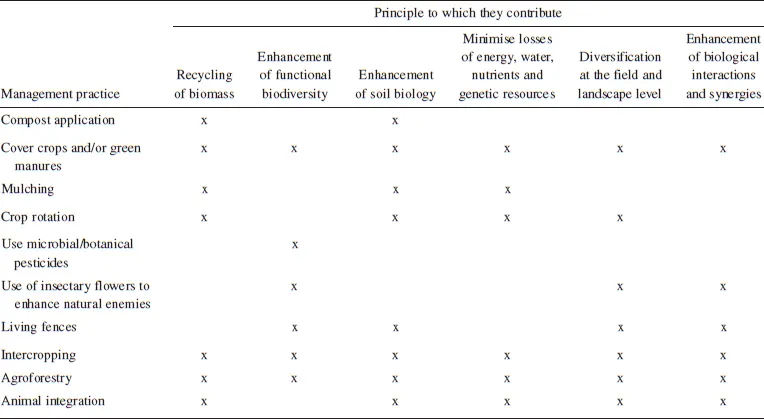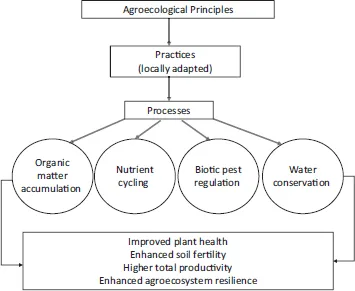![]()
Chapter 1
Agroecological Principles for the Conversion of Farming Systems
Clara I. Nicholls*, Miguel A. Altieri† and Luis Vazquez‡
*Department of International and Area Studies,
University of California, Berkeley, California, USA
†Department of Environmental Science, Policy and Management,
University of California, Berkeley, California, USA
‡Latin American Scientific Society of Agroecology (SOCLA), Cuba
1.Introduction
Modern agriculture consists of the replacement of natural plant communities with artificially supported crop communities. Human manipulation and alteration of ecosystems for the purpose of establishing agricultural production has turned modern agroecosystems into highly simplified systems, to the point that they are structurally and functionally very different from natural ecosystems. The inherent self-regulation characteristics of natural communities are lost when humans modify such communities by promoting monocultures (Altieri and Nicholls 2004). The more intensely such communities are modified, the more abundant and serious the ecological unbalances of simplified cropping systems. For example, Zhao et al. (2015) found in a two-year study of 17, 1500 m-radius sites in China, that input of nitrogen fertiliser and cropland expansion compromised the ability of natural enemies to control cereal aphids leading to a disturbance of the interspecific relationships and enhancing reliance on pesticides.
Reliance on homogeneous monoculture production systems is no longer socially, economically and ecologically desirable as these systems compromise biodiversity, utilise resources inefficiently, are highly energy dependent, impose a major ecological footprint, are susceptible to pest outbreaks and are also vulnerable to climatic variability (Thiessen et al. 2015). In order to face the trade-off between productivity and resilience, a major task for agriculturalists is to find ways to reinstate more ecological rationale into crop production. This new challenge means finding locally suitable designs inspired by observation of local ecosystems and/or successful diversified farms that exist in a particular region (Malezieux 2012). The design of future farming systems must be based on an understanding of how ecosystems are organised and function, and on the realisation that agroecosystems undergoing ecological conversion operate as complex systems with emergent properties, and therefore management decisions must allow for the special behaviours and properties of complex systems.
Agroecology provides the basic ecological principles for how to evaluate why such systems work and provides elements for the design and management of agroecosystems that are both productive and natural resource conserving, but that are also culturally sensitive, socially just and economically viable (Altieri 1995, Gliessman 1998). In this chapter, we argue that modern agroecosystems require systemic change, but new redesigned farming systems will not emerge from simply implementing a set of practices (rotations, composting, cover cropping, etc.), but rather from the application of already well-defined agroecological principles. These principles can be applied by way of various practices and strategies, and each will have different effects on productivity, stability, and resiliency within the farm system. Agroecological management leads to optimal recycling of nutrients and organic matter turnover, closed energy flows, water and soil conservation and balance pest-natural enemy populations, all key processes in maintaining the agroecosystem’s productivity and its self-sustaining capacity (Altieri 2002a).
The agroecological strategy exploits the complementarities and synergisms that result from the various combinations of crops, tree and animals in spatial and temporal arrangements. This is why agroecologists have for some time recognised that intercropping, agroforestry and other diversification methods mimic natural ecological processes, and that therefore the sustainability of complex agroecosystems lies in the ecological models they follow (Altieri 2002b). The challenge to align agricultural systems with ecological principles is immense, especially in the current context of agricultural development where specialisation, short-term productivity and economic efficiency are emphasised. The question of whether the problems of modern agriculture can be ecologically alleviated within the context of the present capital-intensive structure of agriculture is beyond this review.
2.The conversion of farming systems
The reversion of agroecosystems that have already undergone major ecological simplification implies a process of conversion from a high-input monoculture management system to a low-external-input and diversified system (Lamine and Bellon 2009). Most farmers start the conversion process slowly, taking time to gain experience with a more diverse cropping system, to experiment on a small scale, and thus reduce risk, and to learn to be flexible enough to adapt to changing conditions. In general, after 3–4 years of conversion, changes on the soil properties become apparent. The percentage of nitrogen, phosphorus and potassium, pH, organic matter and microbial biomass levels reach values many times significantly higher than at the start of the conversion (Pimentel et al. 2005). Many studies of organic agriculture have revealed better performance than conventional systems on various sustainability metrics, including species richness and abundance, soil fertility, nitrogen uptake by crops, water infiltration and holding capacity, and energy use and efficiency (Kremen and Miles 2012).
The conversion to organic management affects the whole farming system, not only single enterprises. Crop rotations are the main management practices that organic farmers overwhelmingly utilise during conversion as these influence forage production, fertility building and are an integral part of weed, pest, and disease management strategies. A major emphasis during conversion is improving overall soil quality by incorporating organic matter into the soil via the application of animal manures or compost, as well as skilful cover cropping and well planned rotations. In most organic systems, cover crops are the source of the vast bulk of organic carbon inputs needed for the desired soil microbial community and adequate nutrient pool (Lotter 2003). Unfortunately pushed by market forces that privilege specialisation, farmers tend to replace practices such as rotations and cover cropping with a set of energy and capital intensive organic “technology packages, e.g. microbial and botanical insecticides, and biofertilisers”, and input substitutions, making their operations dependent and intensive.
Many authors have conceptualised conversion as a transitional process with three marked phases (MacRae et al. 1990):
1.Increased efficiency of input use through integrated pest management or integrated soil fertility management.
2.Input substitution or substitution of environmentally benign inputs.
3.System redesign: diversification with an optimal crop/animal assemblage, which encourages synergism so that the agroecosystem may provide its own soil fertility, natural pest regulation, and crop productivity.
Many of the practices that are currently being promoted as components of sustainable agriculture fall in categories 1 and 2. Both of these stages offer clear benefits in terms of lower environmental impacts as they decrease agrochemical input use and often can provide economic advantages compared to conventional systems. Incremental changes are likely to be more acceptable to farmers as drastic modifications may be viewed as highly risky. But does the adoption of practices that increase the efficiency of input use or that substitute biologically based inputs for agrochemicals, but leave the monoculture structure intact, really have the potential to lead to the productive redesign of agricultural systems? A true agroecological conversion calls into question monoculture and the dependency on external inputs (Lamine and Bellon 2009).
In general, the fine-tuning of input use through approaches such as Integrated Pest Management (IPM) does little to move farmers towards an alternative to high input systems. In most cases IPM translates to “intelligent pesticide management” as it results in selective use of pesticides according to a predetermined economic threshold, which pests often “surpass” in monoculture situations. Input substitution, used by the large majority of organic farmers follows the same paradigm of conventional farming, overcoming the limiting factor, but this time with biological or organic inputs. Many of these “alternative inputs” have become commodified, therefore farmers continue to be dependent on input suppliers (Rosset and Altieri 1996). In California, many organic farmers cultivating grapes and strawberries apply between 12 and 18 different types of biological inputs per season. In addition to enhancing production costs, many products used for one purpose affect other aspects of the system. For example, Sulphur which is widely used to control foliar diseases of grapes, can also wipe out populations of Anagrus parasitic wasps, key regulators of leafhopper pests. Thus, farmers become trapped in an “organic treadmill”.
Gliessman (2010), argues that improvements in efficiency of input use and input substitution are not enough to address the challenges facing modern agriculture. Instead, he argues that farming systems must be redesigned based on a new set of ecological relationships. This entails approaching conversion as an ecological transition of agriculture based on notions of agroecology and sustainability.
System redesign arises from the application of agroecological principles that lead to the transformation of agroecosystem function and structure by promoting management guided to ensure ecological processes like nutrient cycling, pest regulation, etc. (Altieri and Nicholls 2012). Ultimately system redesign consists in the establishment of an ecological infrastructure that through plot- to landscape-scale diversification, encourage ecological interactions that generate soil fertility, nutrient cycling and retention, water storage, pest/disease regulation, pollination, and other essential ecosystem services.
3.Principles versus practices
As an applied science, agroecology uses ecological principles for the design and management of diversified agroecosystems where external inputs are replaced by natural processes such as natural soil fertility, allelopathy and biological control (Table 1). Agroecology does not promote technical recipes but rather above principles, which when applied in a particular region take different technological forms depending on the local socio-economic needs of farmers and their biophysical circumstances. Each practice is linked to one or more principle thus contributing to its manifestation in the function of the agroecosystems (Table 2). The applied practices set in motion ecological interactions that drive key processes for agroecosystem function (nutrient cycling, pest regulation, productivity, etc.) (Figure 1).
Agroecology is not about promoting a few magic bullet solutions that are divorced from local contexts and that can be disseminated following top-down approaches. It relies on the quality of complex interactions that result from the adequate combination of various practices whose operationalisation in particular circumstances will necessarily have to change depending on each context, since each environment has its own characteristics (Malezieux 2012). The array of cultural practices used by each farmer results in functional differences that cannot be accounted for by any single practice. This is what Andow and Hidaka (1989) called “a production syndrome” defined as a set of management practices that are mutually adaptive and lead to high performance. However, subsets of this collection of practices may be substantially less adaptive, that is, the interaction among practices leads to improved system performance that cannot be explained by the additive effects of individual practices. One of the frustrations of research in the organic/conventional yield gap has been the inability of low-input practices to outperform conventional practices in side-by-side experimental comparisons, despite the success of many organic and low-input production systems in practice. A consistent yield gap of 19–25% is reported when comparing organic and conventional agricultural systems, but interestingly the yield gap is reduced substantially when organic farmers adopt multicropping and complex crop rotations (Ponisio et al. 2015).
Table 1. Agroecological principles for the design of biodiverse, energy efficient, resource-conserving and resilient farming systems.
| 1. | Enhance the recycling of biomass, with a view to optimising organic matter decomposition and nutrient cycling over time. |
| 2. | Strengthen the “immune system” of agricultural systems through enhancement of functional biodiversity — natural enemies, antagonists, etc., by creating appropriate habitats. |
| 3. | Provide the most favourable soil conditions for plant growth, particularly by managing organic matter and by enhancing soil biological activity. |
| 4. | Minimise losses of energy, water, nutrients and genetic resources by enhancing conservation and regeneration of soil and water resources and agrobiodiversity. |
| 5. | Diversify species and genetic resources in the agroecosystem over time and space at the field and landscape level. |
| 6. | Enhance beneficial biological interactions and synergies among the components of agrobiodiversity, thereby promoting key ecological processes and services. |
Source: Adapted from Altieri (1995) and Reijntjes et al. (1992).
Table 2. Relative contribution of several management practices to one or more agroecological principles.
Note: Most of these practices will also appear in the other chapters.
Figure 1. Agroecological principles for the conversion farming systems.
Depending on how it is concretely applied and complemented or not by other practices, one particular practice can sometimes act as an “ecological turntable” by activating key processes such as recycling, biological con...


